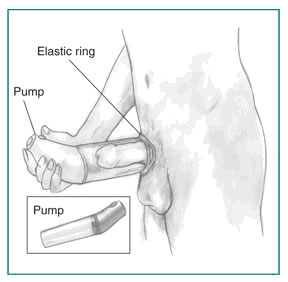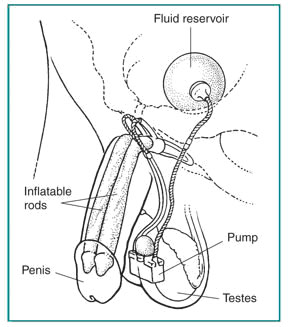Erectile Dysfunction: Diagnosis and Treatment
The Department of Urology at Singapore General Hospital explain how to diagnose and treat erectile dysfunction.

Erectile dysfunction
can be treated with several methods.
Continued from previous page.
Diagnosing erectile dysfunction
-
Patient history. A person’s medical and sexual histories will help define the degree and nature of erectile dysfunction (ED). The medical history can disclose diseases that lead to ED, and a simple recounting of sexual activity might identify problems with sexual desire, erection, ejaculation, or orgasm. The use of certain drugs can also suggest a chemical cause as drug effects are a frequent cause of erectile dysfunction.
-
Physical examination. A physical examination can give clues to systemic problems. For example, if the penis is not sensitive to physical touch, a problem in the nervous system may be the cause. Abnormal secondary sex characteristics, such as unusual hair pattern or breast enlargement, can point to hormonal problems, which would mean the endocrine system is involved.
- The doctor may discover a circulatory problem by observing decreased pulses in the wrist or ankles. Unusual characteristics of the penis itself could suggest the source of the problem – for example, a penis that bends or curves when erect could be the result of Peyronie’s disease.
-
Laboratory tests. Tests for systemic diseases include blood counts, urinalysis, lipid profile, and measurements of creatinine and liver enzymes. Measuring the amount of available testosterone in the blood can yield information on problems with the endocrine system and may explain why someone has decreased sexual desire.
-
Psychosocial examination. A psychosocial examination, using an interview and a questionnaire, can reveal psychological factors. A man’s sexual partner may also be interviewed to determine expectations and perceptions during sexual intercourse.
Treatment for erectile dysfunction
This may include:
-
Lifestyle changes such as quitting smoking, reducing alcohol consumption, losing excess weight, and increasing physical activity may help some men regain sexual function.
-
Cutting back on or replacing medicines that could be causing erectile dysfunction.
-
Psychotherapy. Techniques that decrease anxiety associated with intercourse can be taught together with the help of the partner.
-
Oral or locally injected drugs. Oral drugs called phosphodiesterase (PDE) inhibitors enhance the effects of nitric oxide, a chemical that relaxes smooth muscles in the penis during sexual stimulation and allows increased blood flow in the penis.
- Men who take nitrate-based drugs such as nitroglycerin pills for heart problems should not use any of the three drugs because the combination can cause a sudden drop in blood pressure.
- Drugs such as prostatglandin E1, papaverine hydrochloride, and phentolamine, are injected into the shaft of the penis to relax the smooth muscles of the corpora cavernosa, causing it to become engorged with blood. Patients using such medications should be warned about persistent erection, known as priapism, which requires emergency treatment.
-
Vacuum erection devices. Mechanical vacuum devices cause an erection by creating a partial vacuum, which draws blood into the corpora cavernosa, engorging and expanding the penis. An elastic ring is moved from the end of the cylinder to the base of the penis as the cylinder is removed to maintain the erection.
-
Surgery. This may include:
- Penile implant. Implanted devices, known as prostheses, can restore erection in many men with erectile dysfunction. The implants may be malleable implants or inflatable implants. Once a man has either a malleable or inflatable implant, he must use the device to have an erection. Possible problems with implants include mechanical breakdown and infection, although the incidents of mechanical problems have decreased in recent years because of technological advances.
- Vascular surgery. Surgery may be performed to repair arteries with discrete blockage because of an injury to the groin or fracture of the pelvis. Surgery to block off veins, called ligation, can reduce the leakage of blood that diminishes the rigidity of the penis during an erection.


Figure 2: Vacuum device. Figure 3: Penile implant
Ref: T12
Contributor(s):
HealthXchange Editor
Terms of Use / Disclaimer
All information provided within this web and mobile application is intended for general information and is provided on the understanding that no surgical and medical advice or recommendation is being rendered. Please do not disregard the professional advice of your physician.
